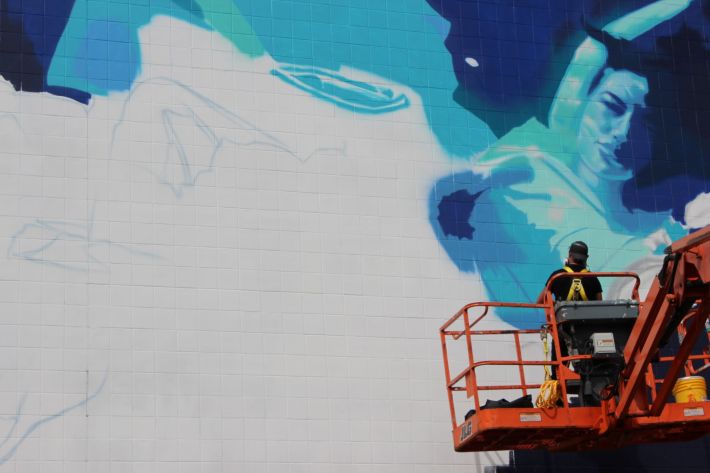You’re an arts organization that promotes public work. Your office is located in an industrial neighborhood filled with huge buildings that have empty walls. What do you do? You find ways to cover it all in murals, obviously.
That’s the gist of Chroma Zone Mural & Art Festival, a multi mural-creation celebration now in its fifth year (minus, you know, some weirdness during early Covid). Basically, artists local, national, and international are invited to create new art either before the event or live over a weekend in the Creative Enterprise Zone of the St. Anthony Park neighborhood in St. Paul. So far, around 50 murals have been created through the project. This year, that number will approach 60.
Perhaps the coolest thing about the series is that Chroma Zone focuses on maintaining a diverse lineup of artists who actually get paid for their work. That shouldn’t be revolutionary, but it is.
“Right away, from the beginning, we knew we wanted to pay everybody. So everyone gets paid,” says executive director Angela Casselton. “And we knew that we wanted to put a special emphasis on artists of color, queer artists, and women. There’s not that many women in this field, but it’s growing.”
Of their 50-some murals, 80% are by artists of color and 50% are by women. And, unlike commissioned work you might see from building owners, artists here get to create the pieces from their own inspiration. This year’s lineup includes Hend Al-Mansour, a Saudi Arabian artist who worked as a doctor in Egypt before getting her fine arts and art history masters here in the Twin Cities; Leslie Barlow, whose work has been featured at the Minnesota State Fair; and neurodivergent autism activist Michael Engebretson.
Chicago-based artist Max Sansing is also in St. Paul this weekend. With a background in both graffiti and fine art, he’s been known to mix the two disciplines into vibrant and unique murals, which he’s created around the world: Sweden, Qatar, South America. He’s also a big advocate for getting more Black artists creating works on walls.
“Seven or eight years ago, I could count on my fingers the number of Black artists that you would see at the mural festivals. There would be like, two token artists,” he says. “It becomes kind of isolating when you don’t see people that look like you after a while.”
In recent years he’s been happy to see more diversity. As one of the founders of BLKOUT Walls Mural Festival, an all-Black artist event in Detroit, he’s an active part of that change.
“I was always pushing for women artists of color, especially in Chicago,” he says of earlier days. “Not a lot of Black women pick up spray cans and start spray painting, you know. I was like, ‘Hey look, whatever you need… I’ll get you on a wall and started. I always get excited when I see artists doing something coming from a different point of view that I’ve never seen before.”
He’ll be at the Wycliff Building this weekend creating a multistory work.
“The kid that I’m painting [for the mural] is pretty much about investing in the youth. These are the heirs of the future,” he says. “I realize that, as I get older, my job goes from being less about what I want to do all the time to being someone that a younger artist can call up. Like a bit of a passing of the torch. I don’t want to be a gatekeeper, because I encountered that a lot when I was younger.”

Mural projects like these are popping up not just around the country, but around the world. And with them comes a change in how we consume art, including who has access to it and who gets to create it.
“And there is power when people see themselves represented,” notes Casselton.
Murals may be one of the oldest forms of art, but they also have the potential to be the freshest. As we saw with the plethora of murals that popped up post-unrest, these public pieces can serve as a disruptor, a healing memorial, and as landmarks representing the people who work, live, visit, and play in the area. Plus, they’re free for all to enjoy.
“I think muralism in general is up, and people are paying attention,” says Casselton. “And I think it’s a direct result of 2020—the pandemic and people’s response to the riots. We were all inside and couldn’t share things. So what’s more public and more accessible than creating your art outside? The whole idea of traditional galleries I think are morphing as well.”
IF YOU GO:
Chroma Zone Mural Festival
You can find a map of locations online at chromazone.net
Thursday through Saturday
Related events include a gallery show and reception at NewStudio Gallery (Thursday); an artists’ talk and market at Vandalia Tower (Friday), and a bus tour of works (Saturday).



